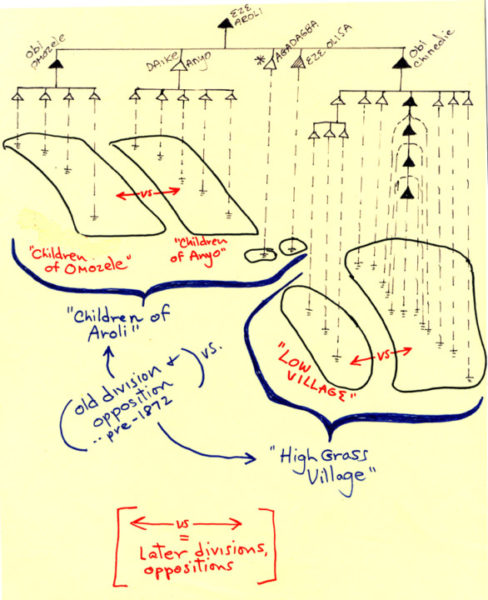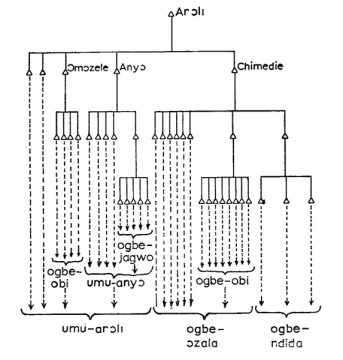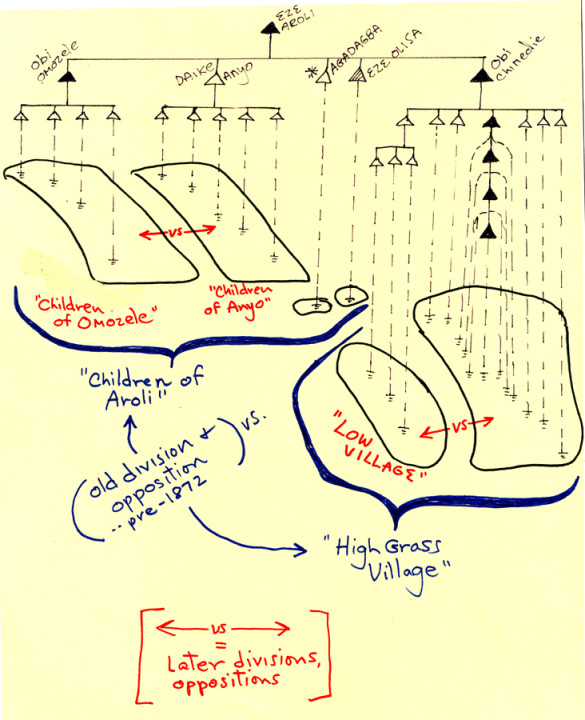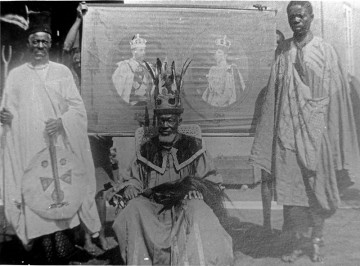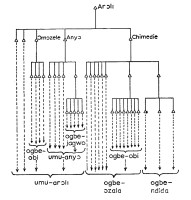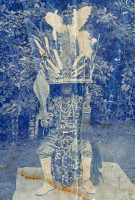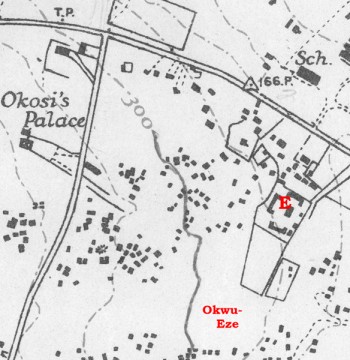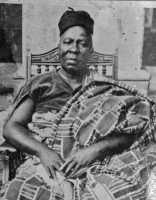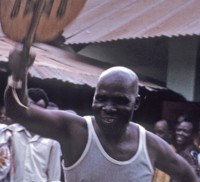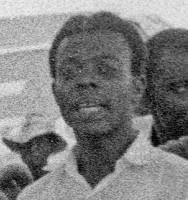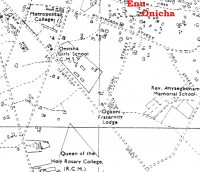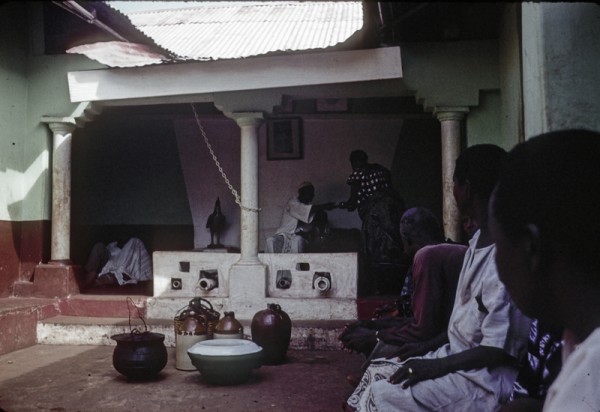“When Our Father is Sought but Not Seen”
(na achoro nna-anyi, ma afu)
[Note: Click on any image you may want to enlarge.]
While as we have just shown, the March Funeral of Obi Okosi II provided a grand (if occasionally discordant) public spectacle announcing his death, Interregnum processes have been been actively brewing within the Inland Town for more than a month. During the first weeks, however, all of this discussion has supposedly been framed rigorously within the boundaries of the publicly‑affirmed legal fiction that he remains alive, and the issue of “appropriate mourning” focuses as harshly within the indigenous community as it does elsewhere, precisely because the struggle for succession in fact became quite active on the very day of the Obi‘s death.
Between his demise on February 2 and the formal announcement on March 10, while the king’s own immediate lineage group has been very busy ritually notifying the various social segments of the Inland Town about the progress of the king’s “illness,” many Onitsha lineages and villages (both royal and non‑royal) have begun holding secret meetings (both informal and formal) about the issue of succession, and in these meetings words like “Abomination” (Alu or Nso-Ani, a polluting moral disgrace, a Sin against the Mother Earth) are often being uttered or implied. This fateful word ‑‑ denoting a contaminating social offense which “sticks” to the offender and increasingly “stinks” like an animal long dead ‑‑ will become a persistent theme of the Interregnum1.
1. February 1961: First soundings of candidates
While our individual talks with a variety of people have suggested to us that many Onitsha men regard themselves as suitable for candidacy (evincing what I have since called “The King in Every Man” dimension of Onitsha society and culture), during the first few weeks I record the names of Nnanyelugo J. J. Enwezor (a well‑liked local businessman, owner of a riverside hotel and various palm oil plantations in the Delta), M. O. Odita (a nationally prominent senior civil servant), J.O. Ikeme (Town Clerk of Aba, previously Town Clerk of Onitsha), Dom Nwoche (Registrar of the Onitsha High Court), Akunne Okolonji Ediboss (a local “playboy” who has a considerable if uneven reputation throughout Nigeria) 2, and Nnanyelugo Joseph Onyejekwe (a Senior Superintendent of the Nigerian Police in Lagos). People affirm that many telephone calls and telegrams are passing between local indigenes and Ndi-Onicha living abroad, of which I hear details regarding only a few.
At first we find the many rumors about meetings, villages, and candidates very confusing. Then a few days after the King’s death, while walking with a group of Isiokwe Village men inside the Inland Town, we encounter at a crossroads a man who is a close agnatic relative of the late Okosi II, who stops to confront the group and says in a challenging way, “So Umu-EzeAroli are playing their tricks again ‑‑ trying to give us an Igbo man (onye‑igbo) for our Obi!” The reference to an Igboman is made with a sneer.
The comments this statement provokes among my companions (including reference to “abominations”) clarifies that the most important early action in Enu-Onicha is taking place within the Umu-EzeAroli subclan of the Royal Clan (Umu-EzeChima), and that its most effective early leader in the succession contest is Nnanyelugo J. J. Enwezor, who is known to have what some consider excessively substantial Ndi-Igbo connections in his family.
The relationships and subsequent interactions among these candidates cannot be understood without exploring the structure of the Royal Clan, including its history, so here I will try to provide a brief account of these matters. We must begin with oral tradition and its probable historical residues.
2. Umu-Eze-Aroli
Probably early in the 18th century, the legendary Eze Aroli is said to have been called by his brothers to return hone to reside in Onitsha from Igala (where “he had been taken as a youth to reside with his mother”), and through divination selected for himself a living site on a hill in the center of the Onitsha village‑group then occupying the land 3. His descendants (including a continuous sequence of 8 kings who succeeded him) prospered, and grew in numbers to become the numerically largest division of the Royal Clan, eventually forming three major Onitsha villages distinguished by name in the early European historical accounts of the town as Ogbeozala (“High‑Grass‑Village”),Ogbendida (“Low‑Village”), and Umu-Aroli (“Children‑of‑Aroli”). The basic genealogical structure that interrelates these three village units is shown in the figure below.4
This Figure shows in general form a genealogical pattern that very likely reflects historical processes of development. (The dotted lines allude to the fact that exact genealogical distances are not represented.) The point is that in precolonial times sub-villages would differentiate from a larger unit when they expanded disproportionately to their equivalent divisions, and for example when they managed to obtain a chieftaincy title within their ranks.
For example, note the Ogbe-Jagwo, “Village of Jagwo“, within the larger village unit called Umu-Anyo (“Children of Anyo“). This marks a difference deriving from the fact that a member (the founder, probably) of this subdivision obtained the chieftaincy title (Jagwo) which enabled them to prosper and to set themselves apart as a distinctive village unit. Probably Ogbeozala emerged as a distinctive grouping soon after the time of King Chimedie, who (together with his immediate descendants and their families) produced a separate village cluster, setting his people apart from the large residual group that continued to bear the original patrilineage name of Umu-Aroli (“Children‑of‑Aroli”).
It is uncertain exactly when Ogbe-Ndida emerged as a distinctive unit, but historical accounts from the 1870s refer to it as “Lower Ogbe-Ozala”, i.e. in Igbo, “Ogbe–Ozala–Ndida. This indicates that the village was differentiating out of the older Ogbeozala, as the genealogy above suggests. By the 1960s, I never hear Onitsha people speak of it by any other name than Ogbendida, but the older name does appear in some written minutes of meetings that are held during this time.
Information from missionary reports suggests that the separation of Ogbendida from Ogbeozala may have first begun to crystallize following political outcomes after the death of Obi Akazua in 1872, when leaders of “Lower High Grass Village” instigated an Interregnum war and brought mercenary warriors from Igala into Onitsha to employ against the “rightful prince” (as the missionaries called him) from Ogbeozala, in order to seize the throne for their candidate, a man the missionaries (and locals as well) described under the name Enendu. Ogbeozala countered by mobilizing an army which included supporters from the nearby Ndi-Igbo town of Obosi, and decisively defeated the pretenders. When in the immediate aftermath of this event the town was swept by a smallpox plague whose victims included the victorious “rightful prince”, the dominant group of Onitsha chiefs blamed the former pretender Enendu for this pestilence, forced him to commit suicide, and they (according to various consultants who spoke with me about this time) are said to have made an oath for Ndi-Onicha to swear that no King or Senior Chief would ever be selected from members of Ogbendida. 5 My Onitsha consultants stated that this event produced the definitive split between the two villages.
Some Ndi-Onicha claim that the third village of the sub-clan, Umu-Aroli, “remained neutral” during this interregnum war, but others maintain that the descendants of Obi Omozele within this group supported Ogbeozala at the time, and implied that other subdivisions of Umu-Aroli (Umu-Anyo, Agadagba and/or Eze‑Olisa segments) supported Ogbendida, thus producing an internal split within Umu-Aroli and intensifying a balance in conflict within the sub‑clan as a whole. It may have been for this reason (impasses within the sub-clan) that contesting parties called in outside mercenaries — from Igala on one side, from Obosi on the other) to break an 1872 deadlock. 6
To assist readers in understand the complexities of Umu-EzeAroli subdivisions and internal conflicts, I herewith attach a diagram I once constructed to provide a visual aid for my own understanding. While it was not prepared suitably for publication (as then projected), I think it’s adequate for our purposes here (although it employs English translations for the village names), so see it directly below:
I hope that will be helpful for those readers less well informed on the subject than I eventually came to be. One point of the diagram is to grasp the difference between “Umu-Aroli” and “Umu-EzeAroli“, the latter term being a 20th-Century construction that refers to the entire set of three major villages — an intellectual device designed to re-unite the three separeated entities.
3. Umu-EzeAroli lose Kingship to Okebunabo, 1900
A great bitterness ensued between the two main contesting villages within what we now call Umu-EzeAroli after this 1872 conflict, antagonism which has to some extent persisted through all the intervening years. When in 1899 King Anazonwu (of Ogbeozala) died, two stubbornly contending candidates arose, one from Ogbe-ndida and one from Ogbe-ozala, and in the struggle which followed other candidates were also presented by the second major royal sub‑clan of Onitsha, a group opposed to all the descendants of King Aroli and who we label as Oke-bu-Nabo (“Division‑is‑Two”). 7.
One member of Okebunabo during the late 19th century was a maamed Samuel Okosi, one of the few literate sons of the earliest Christian converts in Onitsha, who had been a communicant in the longstanding CMS congregation (begun in 1857) before he defected to the more recent Roman Catholic Mission in 1895. Samuel worked as a cook in Aguleri for the Mission Fathers, who saw they had an opportunity to accelerate change in Onitsha and gave their employee strong support as a candidate to succeed Obi Anazonwu (in an era when, as some of our elderly consultants put it in 1961, “we viewed white men as Gods”). Okebunabo now strongly contested the Kingship against the descendants of King Aroli, and indeed a second literate candidate from Okebunabo, Samuel Okosi’s own brother Gbasiuzo, also a literate man, entered the contest as well. Because of the very large population of this long‑dispossessed fork of the Royal Clan, it was able to mount a strong opposition against the bitterly divided Umu-EzeAroli.
Brought to an impasse, the dispute was taken to the new Supreme Court in Asaba, where the British officials holding a hastily‑organized Commission of Inquiry were influenced partly by urgings of the Roman Catholic Mission Fathers to appoint a literate man as king (and no doubt partly by the predispositions of the Roman Catholic official who headed the British establishment there), and in 1901 they chose Samuel Okosi to succeed Anazonwu. The kingship thus passed sharply away from six continuous generations of control by the descendants of King Aroli and into the hands of this second major division of the Royal Clan, long excluded from the throne, but now represented there by a Roman Catholic King.
This British Colonial (and Roman Catholic) intervention generated drastic discontinuities in Onitsha Kingship tradition, and produced deep schisms in Onitsha community which extended into the 1961 Interregnum. From the early 1900s, for example, developed the “tradition” among Ndi-Onicha that “the Obi does not keep juju“, which some Onitsha elders project back into the precolonial past, but this is contradicted by the historical record (For example Mockler‑Ferryman 1892:22-23, who describes his visit to Obi Anazonwu of Ogbeozala in 1889: “”Such is Onitsha’s king. On the ground at his feet lay an earthenware pot containing a cow’s skull, and on a wooden framework in front of the royal seat hung a bell, a horse’s tail, a bundle of short iron spears, and a few other jujus.”. These are standard Onitsha ritual objects.)
The new Obi refused to perform most of the required Installation rituals (especially “Going to Udo” and receiving the “King’s Ofo), and his very crown for his initial Emergence was provided by the RCM, who moved physically (for a time) into his new palace grounds. (The crown shown here above does hold traditional bird feathers, but also features a prominent fleur-des-lis; he does appear to be holding the traditional horsetail switch of mourning, Otinri.) At that time, a very large number of Ndi-Onicha refused to give the new Obi his customary tribute, ridiculing him as “the Book (educational) King” (Eze Akukwo) and “Foreigners’ King” (Eze Oyibo).
4. Land Disputes Restore Unity to A Lost “Family”
However, despite both the bloodshed of 1872 and their loss of the royal dynastic succession in 1901, all three of the major villages descended from Eze Aroli maintained their mutual exogamy through all the intervening years, a clear indication that important grounds of unity have always remained among them. Prominent among these have been shared interests in land.
In 1914, a series of land disputes erupted in Onitsha, involving each of these three villages descended from King Aroli contending with other contiguous Onitsha villages. A social movement emerged among the three to consolidate their causes, and a prominent and wealthy Onitsha ex‑police sergeant named James Egbunike (from Ogbe-ndida) became one of the leaders in a group of men who made an effort to re‑unify King Aroli‘s descendants. They reactivated the traditional communal conclave of the “Elder Dead,” the secret association (Ora-okwute) composed of senior members from the the “Masquerade” or “Incarnate Dead” organization of all three villages, which in earlier times had been a very powerful authority sustaining internal law and order but which during the first years of the twentieth century had been largely suppressed by the Colonial authorities. 8 This revived entity was charged with the task of enforcing internal resolution of disputes.
Second, they established a common fund to pay lawyers hired from Lagos who came to Onitsha to prepare the litigation. As the lawyers investigated these land disputes, they became aware of the need for a common general name to designate the unity experienced by all the descendants of the legendary King Aroli. Since one of the three villages already bore the name Umu-Aroli (“Children‑of‑Aroli“), the people agreed to name the entire sub‑clan comprising his descendants the Umu‑Eze‑Aroli (“Children‑of‑King‑Aroli”), to distinguish the whole group from the sub‑group Umu-Aroli. Under this new comprehensive identification, the three together mounted a series of largely successful land litigations against various other Onitsha villages (as well as against some villages outside of Onitsha), and by the mid-1930s “Umu-EzeAroli” was fully established as their unifying name.
This terminological distinction is not an easy one for an outsider to remember, but the diagram at right is again helpful. Like most newcomers, I frequently confused the two very similar names ‑‑ Umu-EzeAroli, which refers to the entire sub‑clan of Aroli’s descendants, and Umu-Aroli, which refers to only one of the three major village (and lineage) units composed of his descendants ‑‑ but Onitsha people patiently insisted upon my grasping the distinction in this way, and other readers will also find it indispensable for understanding some important points in the process of Onitsha kingship succession. (In the diagram, what we here call Umu-EzeAroli comprehends all three of the villages.)
This grounding of descent‑group or clan unification by means of land‑litigation “technologies” arising in the colonial era was repeated in many Onitsha villages, and with the emergence of the first Ndi-Onicha lawyers in the 1930s, older forms of political competition among these corporate groups were revived in the form of struggles to educate barristers to represent lineage interests. By the time I reached Onitsha, every major village had its pool of lawyers, poised to transform old historic struggles into contests in the courts (and Onitsha indigenes, boasting perhaps the most professionalized small‑community populace in the whole of Nigeria, had gained legal control of a very large area in and around Onitsha Township through aggressive programs of litigation).
A second major long‑term basis of unity among umu-EzeAroli was their shared desire to win back what they believed to be their historically exclusive right to sit upon the Onitsha throne. For some years after 1901 the new King, Obi Samuel Okosi, tried to consolidate his position by many acts of gross favoritism to his own sub‑clan, above all the conferring of the position of Prime Minister (Onowu) upon his own brother (Gbasiuzo Okosi), but also by concentrating other chieftaincy titles within Oke-bu-nabo and by discarding many traditionally required ritual activities of kingship. Such behaviors intensified the alienation and opposition of those who had lost the throne to this Christian convert, and throughout the 1920s leaders of Umu-EzeAroli (and of some other groups) were openly boycotting the king’s palace. In 1926, their most senior chief (Odita, the Ajie, from Ogbeozala in UmuEzeAroli) actually tried to act as king by appointing his own nominee (an Umu-EzeAroli man) to a senior chieftaincy title, and was only prevented from usurping this regal right through a court action directed by the Governor of Nigeria. By this time Obi Okosi had aroused the opposition not only of most Onitsha chiefs outside of his Royal Clan Division but of “the intelligentsia of Onitsha” as well, and only direct British Colonial intervention saved him on this occasion.9
By the time of his death in 1931, “Obi Sammy” (as some of his supporters called him) had considerably transformed his formal style, as evident in this photograph at right from the first Onitsha Almanac (dated 1933), where he was labelled “Late King Samuel Okosi in his full regalia at Ofala Festival”. From Great Tree headdress to bronze sword to leopard-colored clothing to funerary horsetail switch, he was looking the part. He had made sufficient effort to “traditionalize” his reign that his Colonial masters (both the Referend Fathers and the British Officers) came to dislike him, though much Government distaste concerned his town-splitting manipulations of “traditional” offices.10
Thus when Obi Okosi died in 1931, Umu-EzeAroli were vehement in their demand that the kingship be returned to its rightful place, and British officials were by that time sufficiently disillusioned with Okosi’s performance (he had also attained, like his immediate predecessor Obi Anazonwu, a reputation for fantastic feats of drinking, and he had become largely irresponsive to their stated desires) that they too openly favored return of the throne to Umu-EzeAroli, hoping that the intractable factionalism they had repeatedly confronted since 1900 would be somewhat mitigated with a historically more legitimate figure on the throne.
5. The 1931‑35 interregnum
During my research in Onitsha, I obtained a fragmentary set of minutes of “The Ogbeozala-Ugwu Family Association”, dating (where a time-frame is provided) around October-November 1932. 11 These include a typewritten letter sent from a family member located in “The Resident’s Office, Warri”, addressed to an official of the (clearly inchoate) asociation, in which the writer observes that
“..this association is necessitated by the political disquiet in our Town. It would have been a case for the whole Village Group of Ogboza Ugwu na Ndida and Umuaroli, to meet together and select one man for the kingship”.
This statement indicates, first, that the writer is using then-extant British-Colonial language — “Village Group” — to describe their situation. This highly formal and self-consciously literary message does not use the embracive term we have employed here (“Umu-EzeAroli”), though it presumes the larger entity we have been using by that name. (Nowhere in these minutes does that term appear; it apparently lacked consensual formulation at that time.) The “Village Group” is seen to comprise “Ogboza Ugwu” (the latter term indicating higher elevation), “na Ndida” indicating lower elevation”, with “UmuAroli” referring to the residual, older identification.
Judging from other written documents available from the Interregnum, most Ndi-Onicha outside Obi Okosi’s sub‑clan also expected that someone from Umu-EzeAroli would succeed to the throne, but through four years of interregnum the latter group failed entirely to coalesce their support around a single candidate. As if to foreshadow that outcome, the 1932 letter cited above refered dismissively to “a hungry man” seeking “one big meal”.
James Egbunike, the successful trader and ex‑policeman from Ogbe-ndida who had helped lead the 1915 unification of the sub‑clan, had the advantage of being a very influential local man. While that land dispute was brewing he had bought a substantial amount of residence land from Umu-Anyo (in Umu-Aroli village), and built a rather palatial compound there to house himself, his 30‑odd wives, and his more than a hundred children (a set of massive concrete‑block buildings which still stood, when we visited his descendants there in the early 1960s, as a somewhat archaic testament to his 1930s power ). Living in spectacularly regal style and becoming known for his liberality within the sub‑clan (giving many feasts for his relatives and neighbors), he gained numerous supporters for his candidacy by widely distributing his wealth.
Here you see, at left, from the Government 1932 Map of Onitsha, Egbunike’s compound (marked with a capital “E”) at middle far right, a set of three enclosing concrete-block structures oriented around an (elevated) central building. Okosi’s palace at far left does not outshine it in overall dimensions, indeed on the map it looks far smaller than Egbunike’s compound overall. This land of Egbunike’s was outside Ogbe-ndida, marking a potentially new segment of Umu-EzeAroli. I have labelled here the traditional “Sacred Grove of the Kings” (Okwu-Eze) (which by that time presented 30 years of unoccupied high forest). The unoccupied land directly south from Egbunike’s compound was also purchased by the Egbunike family, and had been laid out for development as shown on the map.
Also above, see an undated photograph of candidate Egbunike, who by many accounts was a dynamic and strong-willed person. (He was also long-lived. He died at age 85, just four months before we Hendersons arrived in Onitsha in September 1960. The Nigerian Spokesman of May 18, 1960 provided an obituary.).
However, as a member of Ogbe-ndida he fell under the shadow of the discriminatory oath putatively made by Onitsha chiefs after the violence of the 1872 Interregnum, and therefore he encountered implacable opposition from many members of Ogbe-Ozala and some members of Umu-Aroli (as well as from many other sections of the town). Within Ogbe-ndida itself, he is said to have been secretly opposed by some of his publicly most vocal supporters (who were covertly envious of his parvenu wealth ‑‑ his own father was said to have been an uneducated Onitsha farmer of apparently little distinction).
A second candidate from Umu-EzeAroli was Samuel Nzegwu, from Ogbeozala, who had been educated in Fourah Bay College in Sierra Leone, had traveled as a Native Court Clerk to many parts of Nigeria, and had worked as a contractor in the construction business. He was thus both an educated and wealthy man by the standards of the 1930s, and is said to have spent even more liberally than his rival James Egbunike. (Ndi-Onicha of the time called the Nzegwu family “Sea-Never-Dry” a metaphor capturing local views of the family’s wealth.)
One legend describing his efforts recounts that, having been an early Court Clerk, he gained fabulous wealth through various (often illegal) means but could not deposit such moneys in any European-controlled bank, so he buried it in five holes (called “pots”, each sealed with concrete) distributed about his compound. When he sought the kingship, he gradually emptied all five pots, one after another, nevertheless failing to mobilize enough support to succeed in his quest for the throne. 12
Nzegwu’s main problem was said to be that he had taken his wives from outside Onitsha and and consequently lacked sufficiently strong local connections. (Also, his own mother was an Obosi woman, which even , further weakened his position because of the traditional strength of nwadiani (“daughter’s child”) relationships with one’s mother’s patrilineage , 13 combined with strong historical and contemporary Onitsha antagonisms toward the Obosi Igbo, a factor already noted in Chapter Three, “Newcomers’ Experiences… .) Moreover, while he received some support within Ogbeozala, his paternal ancestral line led directly to one of the brothers of King Ijelekpe about whom unsavory stories were widely told. So despite his unparalleled liberality, his support both within and outside the Royal Clan remained scattered and fragmentary.
A third candidate then emerged from within the Umu-EzeAroli, Ben Nzekwu, a man from Umu-Obi-Omozele who had also lived many years abroad and who therefore had a rather weak local base, but who drew strong, intransigent support from some members of the Umu-Obi-Omozele sub‑group of Umu-Aroli and from some members of his mother’s family in Umu-Dei (of Okebunabo). He apparently did not conduct a very active campaign, but his candidacy further divided the offspring of Aroli.
Finally, there was Obiozo Anazonwu, the son of the last previous king to come from Umu-EzeAroli, but who ‑‑ though Obi Anazonwu had refused to send him for Western education precisely because of the higher calling (kingship) for which he had marked his senior son ‑‑ had failed to succeed his father in 1899. Although by 1931 he held the Senior Chieftaincy position of Fourth Minister (Onya) of Onitsha, and regarded himself as the only valid candidate by virtue of his heritage, he gained very little following for his kingship candidacy even within his own Ogbeozala, yet remained intransigent, refusing to compromise.
Thus four candidates emerged within Umu-EzeAroli, and as years passed and a stalemate developed among them none would agree to step down in favor of any of the others.
6. Okebunabo presents another Okosi
While the members of Umu-EzeAroli became locked in irreconcilable conflict, the diverse segments of Okebunabo coalesced around what seemed to them an obvious and very distinctive choice: the son of Obi Samuel Okosi, James Okosi.
This candidate’s early career provides an illuminating instance of the kinds of social and cultural influences many young Ndi-Onicha experienced during the first half of the Twentieth Century.
Born in 1889, James Okosi was first educated in the RCM Onitsha, and then attached himself in 1904 as a personal servant to the Right Reverend Bishop Tugwell of the CMS and got further education under the aegis of this Bishop in CMS schools in Lagos and Oyo, traveling with this prominent European churchman to various parts of Yoruba country.
Returning to Onitsha in 1906 (and eventually to the RCM as well), he was sent to the new Government School in Onitsha where he passed the College of Preceptors Preliminary Certificate Examination in 1907, and then he joined the Nigeria Civil Service, working first at various stations in the Marine Department and then in various Northern Nigeria provincial departments until he was recalled home in 1931 upon the death of his father. In Onitsha he was quickly proclaimed King by the Prime Minister (Gbasiuzo the Onowu, his own father’s brother), and more importantly received widespread support both in his own sub‑clan and among younger progressive men (what the British officials then labelled the “Intelligentsia”) of the town. For that time, the prospective king was “an educated man”.
Ultimately exasperated by the intractable opposition among the candidates from Umu-Eze-Aroli and influenced by a dynamic new organization formed at the time among the young men and called the “Eight‑Age‑Grades”(Ogbo-Isato), the Colonial Authority bestowed the crown on James Okosi in 1935. Once again the Umu-EzeAroli bloc of the Royal Clan had failed to unite effectively in pursuit of their claim on the kingship, their internal, historically embittering factionalism resisting all pressures for unity. 14
7. Efforts to reorganize Umu-EzeAroli in the 1950s:
The “Ora-Okwute” and the “Peace Committee”
Despite their sense of chronic political failure, and in face of increasing pressure from the youths of these three large villages to break their tradition of mutual exogamy in the interest of increasing the potential pool of women in Onitsha who were both desirable and marriageable, important elders and educated men of Umu-EzeArolii sought instead to forge a more effective union. During the 1940s, recognizing the need for stronger moral sanctions to enforce resolution of their internal disputes, they made an effort to revitalize the Ora‑okwute 15 by bringing the locally‑resident senior priests and titled men together with younger educated persons. Using the younger men as an advisory group, the Ora-Okwute of Umu-EzeAroli had some success arbitrating land disputes among the three villages and also came to function as an agency for parceling out plots of sub‑clan residence land to its individual members, banking the payments in the group’s treasury.
In the early 1950s, encouraged by their success with this traditional institution but also irritated by its inertia, the local younger educated men of Umu-EzeAroli recognized the need for a more dynamic, modern organization to deal with the increasingly complex problems facing the sub‑clan, and decided to form a new, more active (and more modernist) group which became known variously as the “Peace Committee” and the “Regency Council.” As the Regency Council, they now claimed a mandate from their elders to establish a covenant that would guarantee agreement within the entire sub‑clan about which of its segments would have the right at the next interregnum to produce a candidate who could draw the full support of all Umu-Eze-Aroli.
In 1953, the Regency Council did produce a document concerning the kingship, which was apparently accepted and signed by representatives of each sub‑division of the entire sub‑clan. When I arrive in 1960 and speak with people about the probabilities of a future interregnum, most consultants from Umu-EzAroli confidently assure me that they now have a binding secret agreement which will prevent failures like those of the past (though a few express doubt that any formal agreement would prove binding once an interregnum began).
As I later learn, this “treaty of unity for the restoration of our kingdom” established two major divisions ‑‑ Umu-Aroli vs. Ogbeozala and Ogbendida ‑‑ between which pair future successions would rotate. 16 It also established three sub‑divisions within each of these two parts, a sequence of rotation among the six units, and prescribed the sanction of lifetime ostracism from the sub‑clan for any individual or group who might violate any of the provisions of the treaty. However, it gave no answer to a crucial question: Which among these six sub‑divisions will provide the next king, when Obi Okosi II dies?
As the “Umu-EzeAroli Peace Committee,” the same group of leaders began additional activities designed to ensure effective cooperation among the segments of the sub‑clan. When a controversy arose over the distribution of Ozo title money between Ogbeozala and Umu-Aroli, for example, the Peace Committee arranged a settlement. In the late 1950’s, they also began developing a plan to gain control for Umu-EzeAroli over some of the Onitsha lands traditionally claimed by their fellow royal clansmen, the people of Isiokwe. In a variety of ways, this group of local men took over the leadership of the sub‑clan as a whole and developed active programs for pursuing its collective self‑interests.
8. Umu-EzeAroli leadership in 1960
Thus by 1960 a cluster of men residing in Umu-EzeAroli quarters in the Inland Town spend much of their time planning the affairs of the sub‑clan. Some of them have established a high degree of social visibility.
Among traditional leaders, the most prominent person is Simon Egbunike from Ogbe-ndida, a junior brother of the late James Egbunike and the latter’s most active aide during his unsuccessful candidacy for the kingship in 1931‑35. One of the early Native Court Clerks of Onitsha, Simon made himself indispensable as a secretary and advisor to his wealthy senior brother for many years, and in early 1960 he succeeded in breaking through the social barrier of the legendary 1872 oath by which Onitsha people had putatively vowed never to grant senior chieftaincy to anyone from Ogbe-Ndida:. He did this by becominng the Onya, the Fourth Minister (Ndichie-Ume) of Onitsha. By virtue of this new office, he is now the senior political leader of all Umu-Eze-Aroli, and therefore he assumes the chairmanship of the Peace Committee, holding most of its meetings in his house. He draws around himself some of the local members of the Peace Committee as close confidants, and encourages other of his trusted colleagues to participate more actively in the meetings of the group.
One of the Onya‘s closest associates is John Ochei, a fellow member of Ogbe-ndida who describes himself as a “contractor” ‑‑ a label which in Onitsha may cover a very considerable range of entrepreneurial skills. Highly intelligent but very modestly educated by Ndi-Onicha standards, he has been unable to hold jobs that suit his aims and so he has devoted many years to a kind of opportunistic lifestyle in the Inland Town which other similarly‑situated young men sometimes pursue, exposing himself to a great deal of traditional customary ritual activity and also attending the daily affairs of the various Courts of Law located in Onitsha, thus attuning himself to methods of legal procedures abd reasoning.
On the basis of these experiences, he forges a fairly comprehensive if highly legalistic vision of “traditional” Onitsha culture, which he seks to employ for promoting the interests of his family and village. Most Onitsha villages and families have one or more men of this sort, “cultural brokers” in a sense whose livings are derived by employing specialized knowledge toward manipulating symbolic constructions of the contemporary scene. 17
Another aide to the Onya is Dom Nwoche, of Ogbeozala, who as the Onitsha High Court Registrar holds an unusually valuable position for sensing and influencing affairs impinging on legal matters concerning the Inland Town. He has helped mastermind the forming of the Peace Committee, and together with James Ochei and the Onya, the three men are implementing their plan to mobilize a collective effort to acquire control of lands long held by Isiokwe, the village in Odoje whose founding fathers were brothers of Eze Aroli.
Learning that Isiokwe village compiled an official map of their own lineage‑communal lands for use in a court case they won against the town of Obosi, the Umu-EzeAroli Peace Committee managed to obtain a copy of this map and used it as the basis for one exhibit in their new claim that Umu-EzeAroli should have a share in the Isiokwe lands in question. A litigation over this issue was pending in Onitsha High Court when King Okosi II died.
A third friend of the Onya within the Peace Committee is J. J. Enwezor, an Ozo-titled man (“Nnanyelugo”) from Umu-Aroli, Umu-Anyo subdivision (See the genealogical Figure above). After working some years in Northern Nigeria, Enwezor has spent most of his mature years in Onitsha, first as a Road Inspector for the Public Works Department and then as a private contractor operating “J. J. Enwezor’s Engineering and Constructing Company Ltd.,” a substantial business enterprise employing more than 200 road laborers. One of very few Onitsha Indigenes operating a substantial, successful local business by the 1960s, he has expanded his commercial holdings to include a 100‑acre plantation located in the Niger Delta and ownership of a hotel located near the main market lorry park in Onitsha Waterside. Aside from his significant private fortune, he has recently landed an Eastern Regional Government road‑building contract worth more than £50,000, so by the end of 1960, at age 61, he has available a very considerable monetary fund.
Not well-educated by contemporary Onitsha standards (the late James Okosi’s formal attainments — considered by many Ndi-Onicha in 1961 to be inadequate for contemporary times — were stronger than his, and while some Onitsha people are now holders of Ph.D.s, he has only an incomplete primary schooling), Enwezor is however widely admired as a notably generous Ozo-titled man in the Inland Town and he commands a high degree of respect and affection among Umu-EzeAroli, where he is known as an effective peacemaker.
For example, during the early phases of the Peace Committee’s operation a conflict arose: a man who was a native of Ogbe-Ozala but who had become alienated from them and chose to live instead with Umu-Aroli, precipitated a vitriolic dispute by stubbornly giving a critical portion of his Ozo title money to the latter group instead of to the former (who had rightful claim over this money by virtue of his descent position within their line). As a member of Umu-Aroli, Enwezor resolved this conflict by presenting £250 in cash, out of his own pocket, to the titled men of Ogbeozala. Consistently he backed his vocal belief in the importance of cooperation and goodwill within the sub‑clan by making substantial gifts that contributed to such integration. Occasionally the Umu-EzeAroli Peace Committee minute books recorded his efforts, as in one instance in November of 1958: 18
The Chairman and Nnanyelugo Enwezor were thanked for piloting the ship of the Committee to the present distance which is not far from its destination. Enwezor was particularly thanked for donations in cash and kind to the Committee.
Enwezor also employed his fortune to further the interests of his own sub‑village within Umu-Aroli, the Umu-Anyo, for example paying out of his own pocket to rebuild and rededicate some of their neglected communal shrines and financing some of their land litigations. In one important case, he represented the group in a suit brought (in Onitsha Native Court) against their own Diokpala, their senior lineage priest (who had become alienated from the group over his depressed financial condition and the group’s persistent refusal to help finance his taking of the Ozo title). Thus Enwezor contributed to preventing what would have proved a disintegrative subdivision of Anyo‘s communal lands. Afterwards, the other members installed Enwezor as a deputizing senior priest for Umu-Anyo, a surrogate for the rightful (but alienated) man, who could not act in this role because of his lack of Ozo title. 19. Later Enwezor even managed to bring this man back into the fold (though his Ozo title remains an unattained goal when we are in Onitsha).
In addition to his various roles within Umu-EzeAroli, Enwezor has established an abiding and very important personal relationship with Simon Egbunike, the Onya. In part this is grounded in the earlier purchase by Simon’s senior brother James of the plot of land formerly owned by Umu-Anyo and located immediately adjacent
to Enwezor’s residence compound there. (This is the property marked “E” for Egbunike on the map at left. The Onya claims a share of this estate (which is currently in litigation between him and James Egbunike’s sons), and his own house is directly contiguous to Enwezor’s section of Umu-Anyo sub‑village. More importantly, when early in 1960 Simon Egbunike contested for the Fourth Minister position, many people in Umu-EzeAroli strongly preferred Enwezor for the post and tried to convince him to become a candidate. Enwezor however declined in favor of his friend, and (so I was told) may also have assisted Egbunike’s candidacy with a substantial cash loan. The Onya is thus in some ways obligated and committed to Nnanyelugo Enwezor and to his sub‑village.
In addition to his expansive relations within the Inland Town, Enwezor cultivates many contacts outside. His contracting business of course leads him into diverse non‑Onitsha circles, and he participates in a number of trans‑ethnic associations,
including the locally very important institutions of Freemasonry and the Reformed Ogboni Fraternity (the R.O.F., whose cultural roots derive from Yorubaland but whose membership has become universalistic in modern Nigeria).20 The R.O.F., for example, has a membership of about 200 in Onitsha in 1961 (including 35 women), a majority of whom are non‑Onitsha, Ndi-Igbo traders (predominantly from Nnewi town), and Enwezor is frequently involved with this group. He also plays an active role in the local NCNC, to whom he regularly donates substantial amounts of money.
One other notably prominent Umu-EzeAroli man living in the Inland Town at the time of King Okosi’s death is Moses Odita of Ogbe-ozala, whose father ‑‑ a son of Prince Odili, senior son of Obi Akazua ‑‑ had been the Ajie (Onitsha’s Second Minister) in the 1920s, when for a time this Senior Chief was supported by many Umu-EzeAroli people as the rightful King of Onitsha.
By 1961 Moses Odita is a young elder in his early fifties who has worked for 32 years in Colonial Government Administration, traveled extensively throughout the country in various tours of service, participated actively in creating an innovative Community Development Project during the 1940s (which received a degree of international recognition), has risen to the position of Higher Executive Officer in the Colonial Administration, and has recently received the coveted M.B.E. award (“Member of the Civil Division of the Most Excellent Order of the British Empire”, bestowed upon him by Her Majesty Queen Elizabeth II). For many years he has also played a quite prominent role in the affairs of the local Roman Catholic Mission. When early in our stay I ask one of the Irish Priests why so few Onitsha men appear to remain loyal Catholics these days, he observes that “there are a few who do, and those are truly outstanding, like Moses Odita.”
Although a devout Catholic churchman, Odita had (as a boy in Onitsha) acted as bell‑carrier for two Senior Chiefs, and he can therefore claim deeper knowledge of native law and custom than most well‑educated Onitsha men of his time (indeed, deeper than most less-educated locals as well). For some years he has openly expressed his interest in the kingship, and when during the first months of my fieldwork in 1960 I discuss the future of kingship with Onitsha people, his name is invariably mentioned as the most prominently likely successor to the throne. During that time, however, some people do however voice hostility towards his Roman Catholicism; one man genealogically and officially very close to Okosi II, who claims himself to be a Roman Catholic, vows to me that “Those Irish Mission Imperialists have ruled us through one of their puppets since 1900. They’re not going to do it again!”
Odita’s Christian devotion has also prevented him from actively participating in Inland Town affairs although that is the location of his current residence. For example, he is not a member of the Umu-Eze-Aroli Peace Committee, and since the RCM Fathers systematically refuse to allow their communicants to take Ozo title, he remains an untitled man and therefore lacks formal “voice” in the affairs of his lineage. He is otherwise of course highly qualified to occupy very influential positions in the traditional affairs of the community.
The allusion just made to voice is not trivial, but forms a crucial metaphor for the centrality of the Ozo title in Onitsha traditional culture. This is not the place to elaborate the point, but Odita’s lack of this pivotal social title is a critical fact in the narrative which now follows.
9. February 2, 1961: Umu-EzeAroli reacts to Okosi II’s death
By his own later account, Moses Odita learned of the death of Okosi II the same evening it occurred, and he went immediately to consult with his brother George and with John Ochei (both of whom are members of the Peace Committee). Together they walked to the house of the Onya, where they met with him around midnight. The Onya asked Moses if he would accept the kingship should it be offered him, and Odita replied yes. (Odita later claimed that he understood from this initial meeting that the Onya, John Ochei, and other members of the Peace Committee fully intended to support his candidacy. )((See Harding 1963:59.))
On the following days the Onya convens a number of secret meetings of various members of Umu-EzeAroli at his house and perhaps elsewhere. How many there are is uncertain, and the attendance is varied. At the time I hear only scattered rumors about these meetings from non‑participants, who claim that already Umu-EzeAroli are in deep disagreement amongst themselves. The Onya however later affirms that these initial conclaves produced a mandate for the Peace Committee to select (from among the names submitted at the time) one single candidate to represent the Sub‑clan. The Peace Committee therefore convenes another secret meeting on the 7th of February, to decide who will become the UmuEzeAroli candidate to succeed Okosi II. 21.
This meeting is held that evening in the home of Emmanuel Enwezor, the senior son of J. J. Enwezor and a recently‑married civil engineer who has just constructed his new house inside his father’s compound. (The Onya later explains that this unusual choice of meeting location was dictated solely by a desire for secrecy.) At this time a number of persons, including Moses Odita, are “co‑opted” into the Peace Committee, and a total of 18 men attend the meeting. According to the Peace Committee minute books22, four names are presented to the Onya, and then discussion of the potential candidates’ qualifications begins. “It was agreed that any candidate selected for the office should be ‑‑ (a) financially good, (b) socially fit, (c) one whose past performances was [sic] good….” 23
Then, since two attending members of the Peace Committee are named as candidates ‑‑ J. J. Enwezor, a regular member, and Moses Odita, a newly co‑opted one ‑‑ these two men are asked to leave the meeting while the remaining members cast their votes. From Odita’s later perspective, he says that when he and Enwezor walk out into the night to await the decision, he distinctly hears the clinking of beer bottles being handed around inside the house, and he wonders aloud whether he should have provided his ’round’ for the members. But Enwezor reassures him that it is not necessary; everything has already been taken care of. 24
Inside Emmanuel Enwezor’s house, (according to the Minute Books) a secret ballot is taken and counted, and then the Committee frames a “Resolution”: 25
“That this Committee that have been mandated by the elders and people of Umu-EzeAroli have by secret ballot elected Mr. J. J. Enwezor for the approval of Umu-EzeAroli as candidate for the vacant throne of Obi.”
The votes were as follows:
Robinson Egbuchi 0 vote.
John Ikeme 1 vote.
Moses Odita 3 votes.
J. J. Enwezor 12 votes.
“It is also agreed that anybody from the said Umu-EzeAroli family who defies this decision and puts himself up as a candidate or supports any other candidate than J. J. Enwezor shall be ostracised ‑‑ that is to say, he shall neither take part in any affair or ceremony pertaining to the whole or part of Umu-EzeAroli. He shall forfeit all benefits due him in any capacity and he shall not visit any member of Umu-EzeAroli nor shall he be visited by anybody.”
Ostracism (nsupu), a form of social death 26, is intimately related to the symbolic death‑and‑killing political thematics discussed earlier in this work, and its overt threat here constitutes a powerful social pressure to generalize the Peace Committee’s commitment to all Umu-EzeAroli.
The Onya then calls the elders and youths of Umu-EzeAroli to meet with the Peace Committee, aiming to obtain their binding consent to this resolution. However, at this subsequent meeting, the names of three additional candidates are submitted, there is disagreement over the decision that has been made, and the group advises the Committee to reconsider all seven applicants at another meeting.
The Committee does so, but reaffirms their commitment to Enwezor. According to the Committee Minute Books, they then convene another meeting with “Umu-EzeAroli Elders,” and the minutes attest that spokesmen of both “elders” and “youths” record “their decision to support whole and entire the candidature of Mr. Enwezor”. 27
Moses Odita and numerous other members of Umu-EzeAroli are stunned both by the speed with which the issue of the successor has seemingly been decided, by the nature of the decision, and by its vehemently aggressive finality as well. By February 18, Odita recovers his composure enough to write a letter to the Onya “…to express my entire lack of confidence in the machinations of a majority of the members of our Committee.” He alleges that “the Committee which did the election co‑opted certain gentlemen… for a set purpose,” and that he has since learned that “before the election Mr. J. J. Enwezor went around the Committee Members and others ‑‑ even in my own family ‑‑ to campaign against me.” In a subsequent letter, he adds the point that “If the cherished customs and traditions of Onitsha are anything worth recognizing, this candidate’s maternal line and his paternal appendage to the Anyo family of Umu-Eze-Aroli should be fully investigated”. 28
These quotations reflect some of the intensity of the opposition to Enwezor quickly emerging within the sub‑clan, a problem also raised in one Peace Committee minutes remark that “The burning question that the mother of the elected candidate was from Nsugbe was discussed at length” 29.These issues are the most prominent rumors to breach the boundaries of Umu-EzeAroli in the first days of the campaign, when I hear numerous people simply dismissing Enwezor’s candidacy. Some speak sarcastically of “Eze Aroli from Nsugbe” (Enwezor’s mother being indisputably from Nsugbe Town); others ridicule Umu-EzeAroli for their chronic inability to mobilize support behind a “suitable candidate”. The various versions that I hear circulating at this time about these secret meetings suggest depths of disagreement within the sub‑clan not in evidence when passages from the Peace Committee Minute Books are much later later made public through the Inquiry.
10. February 15: Ethnographer meets Enwezor
When vague but clearly controversial news about the Enwezor’s candidacy reach me, I go to consult him and ask permission to witness the ritual procedures I have heard he is about to undertake. Though we had been introduced during an Ozo-title-taking occasion prior to Obi Okosi’s death, I had never previously visited his home. Driving to the village of Umu-Anyo, I stop along Bishop Onyeabo street and enter the Enwezor compound, which is dominated by the candidate’s massive Ancestral House, constructed in fairly strict traditional style but with high‑grade concrete walls and floors and corrugated iron roofs.
The altar in his central courtyard is particularly striking (and unique among those I see in Onitsha), in that it faces the courtyard with a low, whitewashed rectangular wall containing small portholes through which protrude the muzzles of what appear to be old Portuguese cannons, as though the altar were a battleship confronting any assembled congregation with great and threatening firepower.
After a brief wait I am escorted behind the altar into his private quarters, where Nnanyelugo Enwezor sits in a lounge chair, robed and capped in white, receiving a number of visitors who face him along the opposite wall. As I sit down beside them to wait my turn, I notice a flurry of movement by some of his young attending boys, one of whom leaves the room and returns soon thereafter, bringing what appears to be a letter or memorandum and presenting it somewhat theatrically to Enwezor. The candidate unfolds a pair of reading glasses, carefully puts them on, and peruses the proferred paper for some time.
When he later greets me, and offers me beer, I thank him, tell him I undersand he is pursuing the Kingship, and request permission to attend as many of his forthcoming activities as will be convenient for him, in order to pursue my research. With a relaxed and accommodating smile on his open, ruggedly lined face, he bids me a warm welcome to Umu-Anyo Village and says his doors will be open to me, that I can freely work with him and among his people.
Departing, I wonder about the apparently ritualistic presentation of the letter, which strikes me as a declaration to the unanticipated and unfamiliar “European” visitor that Enwezor can read. ( When I initially enter any unfamiliar social scene in these days, someone often seems to assume I am a European “authority” of some kind and quickly constructs a theatrical stage of sorts, accommodating that assumption.). I might have expected something like this in the Ndi-Igbo hinterlands (where a much smaller proportion of the populace is educated and where literacy is still publicly celebrated in major rituals), but never encountered it elsewhere in Onitsha Inland Town, where competitive display focuses rather on the quantity and quality of one’s traditional titles and/or University degrees. (So impressed were we with the overall levels of indigenous Onitsha literacy in English that we came to expect new acquaintances to display indications of at least primary school education.)
I also wonder about the contrast between the shape of Enwezor’s public altar and his style of personal interaction, which is one of relaxed geneality and generosity (consistently sustained in many subsequent meetings ‑‑ he behaves in an unfailingly accommodating and cordial manner to me, and has powerful skills for putting visitors at ease). Later when I sit near him at unguarded times and hear him loudly grinding his teeth, I sense more clearly a state of interior tension that is strongly masked by his unfailingly affable greeting style.
My experience in subsequent unscheduled visits to Enwezor’s private quarters include encounters with European businessmen consulting with him there. This is unique in my Onitsha experience (though my visits to Onitsha elites during working hours are too few to draw any sound inferences about the frequency of such interactions since I spend so little time outside the Inland Town. Very few Europeans are at this time living in Onitsh. ). At any rate, these encounters clearly reflect in some measure a breadth of active local social contacts outside the Inland Town and across ethnic groups which is unusual among those residing there.
Non‑Onitsha Ndi-Igbo people I later speak with about the Interregnum uniformly express positive interest in Enwezor’s candidacy, precisely on the grounds of his openness to outsiders and his reputation for generosity toward all who approach him.
11. Some Voices Proclaim “Abominations” (Alu)
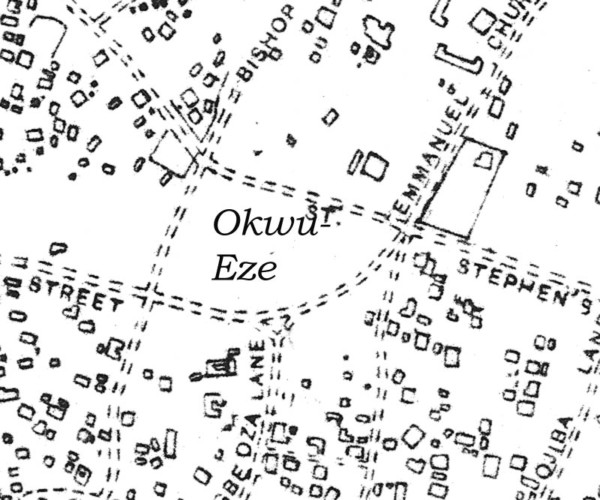
Enwezor’s pursuit of the Kingship at this stage draws its most intense reaction in the Inland Town when, only five days after the Obi’s death, the Peace Committee of Umu-EzeAroli authorizes the cutting of the great Sacred Grove of the Kings (Okwu-Eze), the high rain forest said to contain the ruins of all the Aroli Kings who had reigned from the time of King Chimedie through that of Obi Anazonwu.
In a few brief days this large and spectacular stand of forest (which had grown rank and tall in the very center of the Inland Town for most of the 60 years’ reigns of Obis Okosi I and II) is demolished by a maqssive attack with saws and bulldozers, leaving a barren open field for the most part devoid even of stumps. (According to some informants, many high trees of this Sacred Grove of the Kings were felled in 1917 after the installation of the late Obi Anazonwu’s son as the Onya, but according to Onitsha people no farming, firewood cutting, or residing was allowed there.)
In any case this was the densest, most impressive body of forest I saw in or near Onitsha. Readers can imagine my dismay that I had entirely failed to photograph or explore it before its abrupt destruction in February of 1961. I am somewhat baffled to this day that I didn’t learn of the mass-destruction until it was finished. It must have been done with great efficiency and dispatch.
Loudly and aggressively, many Onitsha people from all the Nine Clans condemn this action as an Abomination (Alu, the form of “sticky” taboo-breach that earned it this translation-term in Biblical English).
Curiously, Inever heard any discussion regarding who profited from the disposal of this huge mass of tropical timber. The proceeds distributed through this action must have been substantial. As the Senior Chiefs in charge of Umu-EzeAroli, the Onya and his Peace Committee had to be directly involved.
Some people say that this kind of activity ‑‑ performed not only without consultation of the community as a whole but also well before the King’s death has even been announced, and hence constituting a kind of premature “announcement” of Interregnum (equivalent to the newspaper episode of “wishing the Obi dead” decried in previous pages here, and symbolically equivalent to the killing of the King himself by virtue of his image as a “Great Tree”) ‑‑ is merely the expectable consequence of the failure by Onitsha people to abide by their 19th century Oath forbidding the conferral of any Senior Chieftaincy title upon any member of Ogbe-ndida.
This statement represents a direct attack on the Onya, whose acquisition of his title in 1960 has supposedly broken that oath. One elder tells me many people are now claiming that this last-named moral transgression by Obi Okosi II — having bestowed the title on Simon Egbunike — was probably the cause of his death, since less than a year had elapsed between the Onya‘s accession to his title as Fourth Minister and the Obi’s demise (The spiritual force acting on oath‑bonded commitments is said normally to exercise its effects within one year. ). Others, however, generalize their attack: this is merely “Umu-EzeAroli acting like Kings” ‑‑ that is, disregarding customary constraints and doing as they see fit. 30.
As news of this latest breach of tradition spreads through Enu-Onicha, and the outcry of “Abomination!” follows it, Onitsha people everywhere are preparing for further conflict. They know well (as I am only sometime later to learn) that one phrase to be employed when they engage in activities roughly equivalent to those described in English as “power politics” is “Abomination Combat” (Agha-Alu), and Abominations bring in their wake many mysteriously meaningful deaths. In such circumstances, Onitsha proverbially becomes like “a mother who is both pregnant and nursing at the same time” (a moral contradiction for traditional Ndi-Onicha). 31.
In my own experience of these events, my most potent memory is the voice of the man who accuses the Umu-EzeAroli of trying to impose on Onitsha people an “Igbo‑man” (this word being spoken with an unmistakable sneer). On the one hand, Umu-EzeAroli are viewed as in some sense the epitome of Ndi-Onicha ‑‑ “core” royalty, most centrally possessed of the distinctive character of kingship. On the other hand, the man this group is most prominently pressing forward as their candidate for the royal throne is widely known for his kinship and other social connections with Ndi-Igbo ‑‑ by either standard, he is by no calculation a pure type.
- For details on this complex, see Henderson 1972:565, under the heading “Abomination” [↩]
- A music hall comedian and clothes-horse “dandy”, he also served as a “tout” for Onitsha lawyers seeking business in rural Igboland. See Akosa (Chike) 1987, pp. 159-62 for a brief resume of his career. While I never found reason to regard him as a serious candidate, he clearly had celebrity status in Onitsha. See Chapter 6 for further reference to his Interregnum role, which was considerable. [↩]
- See Henderson 1972:86‑94 for one account of this legend. [↩]
- Copied from Henderson 1972:182. [↩]
- Much dispute remains over this issue. See Henderson 1972:463-6; 487-90. My 1960-62 informants disagree on the issue (see also recent books by indigenes). We will also find it important in the current Interregnum conflict in 1961‑2. [↩]
- See Henderson 1972: 455-58. These alignments cannot be described with certainty. But note that these historical accounts point to an apparent complexity of internal clan alignments and oppositions, and also the importance of outsiders in effecting a decisive outcome, a perennial problem in Onitsha. [↩]
- This major village is also sometimes labelled Umu-Dei (“Children‑of‑Dei”), but since this is also used to identify a major subgroup of Okebunabo, I will try to distinguish the two levels where confusion might otherwise result. See Henderson 1972:460-63, 471. [↩]
- Henderson 1972:567‑8; other sources for this come from from early administrative records ‑‑ q.v. [↩]
- See AROP 1926 for an account of this situation, which shows how he had systematically undermined Umu-EzeAroli leadership in favor of Okebunabo. [↩]
- OPAR 1931 vol 9: “The ratification of Obi Okosi’s appointment by the District Court of Asaba (in 1900) does not appear to have been a particularly successful piece of diplomacy.” [↩]
- Ogbeozala-Ugwu Family Minutes, pp. 26-42. [↩]
- This tale, one of the most widely‑told to me during the 1961-2 interregnum, was consistently used to emphasize the secondary significance of money in deciding succession to kingship. [↩]
- See Henderson 1967:44-46,1972:235-240, 424-7. [↩]
- The constructive role of the Ogbo-Isato will be dealt with elsewhere in this work. [↩]
- See Henderson 1972:362-6 for an account of this traditional organization. [↩]
- Note that this implied that the putative 1870s Oath denying the latter village eligibility was not a relevant consideration. [↩]
- See below, in this chapter: “Newspapers and Cultural Brokers”. [↩]
- Cited in Harding 1962:60. [↩]
- See Henderson 1972:249-52;262-4 on Ozo title as prerequisite to traditional voice within both descent group and village. [↩]
- The map at left shows its location, surrounded by various schools All of these modern-use lands were purchased from Enu-Onicha villages. [↩]
- See Harding 1963:62-3. [↩]
- Later submitted to the Harding Commission, see below [↩]
- Harding 1963:61. [↩]
- Ibid.:62 [↩]
- Ibid. [↩]
- See Henderson 1972:139,474 for accounts of the process in different arenas [↩]
- Ibid.:62‑3. Note that the details of these meetings, later presented as Peace Committee Minutes to the Harding Commission of Inquiry, were subjected to considerable dispute during the Inquiry. [↩]
- Quoted from my own Interregnum files. [↩]
- Harding 1963:63. [↩]
- See for example Henderson 1972:483, for the stereotype of Ogbeozala, whose members controlled Kingship for generations prior to 1900, as “those who lie and deceive” [↩]
- See Henderson & Henderson 1966:20. [↩]
